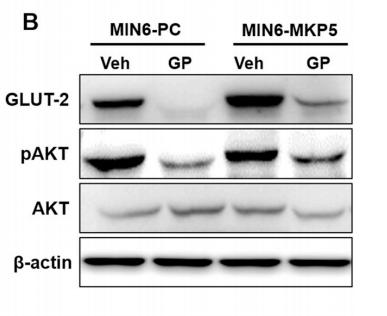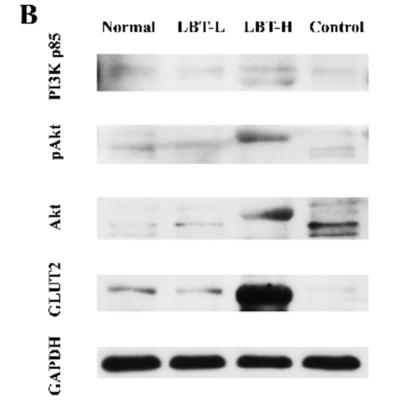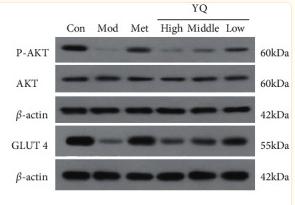GLUT2 Antibody - #DF7510
| Product: | GLUT2 Antibody |
| Catalog: | DF7510 |
| Description: | Rabbit polyclonal antibody to GLUT2 |
| Application: | WB IHC |
| Cited expt.: | WB |
| Reactivity: | Human, Mouse, Rat |
| Mol.Wt.: | 57 kDa.; 57kD(Calculated). |
| Uniprot: | P11168 |
| RRID: | AB_2841009 |
Related Downloads
Protocols
Product Info
*The optimal dilutions should be determined by the end user. For optimal experimental results, antibody reuse is not recommended.
*Tips:
WB: For western blot detection of denatured protein samples. IHC: For immunohistochemical detection of paraffin sections (IHC-p) or frozen sections (IHC-f) of tissue samples. IF/ICC: For immunofluorescence detection of cell samples. ELISA(peptide): For ELISA detection of antigenic peptide.
Cite Format: Affinity Biosciences Cat# DF7510, RRID:AB_2841009.
Fold/Unfold
liver; Glucose Transporter 2; Glucose Transporter GLUT2; Glucose transporter type 2; Glucose transporter type 2 liver; Glucose transporter, liver/islet; GLUT-2; GLUT2; GTR2_HUMAN; GTT2; SLC2A2; Solute carrier family 2 (facilitated glucose transporter) member 2; Solute carrier family 2 facilitated glucose transporter member 2; Solute carrier family 2, facilitated glucose transporter member 2;
Immunogens
A synthesized peptide derived from human GLUT2, corresponding to a region within N-terminal amino acids.
- P11168 GTR2_HUMAN:
- Protein BLAST With
- NCBI/
- ExPASy/
- Uniprot
MTEDKVTGTLVFTVITAVLGSFQFGYDIGVINAPQQVIISHYRHVLGVPLDDRKAINNYVINSTDELPTISYSMNPKPTPWAEEETVAAAQLITMLWSLSVSSFAVGGMTASFFGGWLGDTLGRIKAMLVANILSLVGALLMGFSKLGPSHILIIAGRSISGLYCGLISGLVPMYIGEIAPTALRGALGTFHQLAIVTGILISQIIGLEFILGNYDLWHILLGLSGVRAILQSLLLFFCPESPRYLYIKLDEEVKAKQSLKRLRGYDDVTKDINEMRKEREEASSEQKVSIIQLFTNSSYRQPILVALMLHVAQQFSGINGIFYYSTSIFQTAGISKPVYATIGVGAVNMVFTAVSVFLVEKAGRRSLFLIGMSGMFVCAIFMSVGLVLLNKFSWMSYVSMIAIFLFVSFFEIGPGPIPWFMVAEFFSQGPRPAALAIAAFSNWTCNFIVALCFQYIADFCGPYVFFLFAGVLLAFTLFTFFKVPETKGKSFEEIAAEFQKKSGSAHRPKAAVEMKFLGATETV
Research Backgrounds
Facilitative hexose transporter that mediates the transport of glucose and fructose. Likely mediates the bidirectional transfer of glucose across the plasma membrane of hepatocytes and is responsible for uptake of glucose by the beta cells; may comprise part of the glucose-sensing mechanism of the beta cell. May also participate with the Na(+)/glucose cotransporter in the transcellular transport of glucose in the small intestine and kidney. Also able to mediate the transport of dehydroascorbate.
N-glycosylated; required for stability and retention at the cell surface of pancreatic beta cells.
Cell membrane>Multi-pass membrane protein.
Liver, insulin-producing beta cell, small intestine and kidney.
Belongs to the major facilitator superfamily. Sugar transporter (TC 2.A.1.1) family. Glucose transporter subfamily.
Research Fields
· Human Diseases > Endocrine and metabolic diseases > Type II diabetes mellitus.
· Human Diseases > Endocrine and metabolic diseases > Insulin resistance.
· Human Diseases > Endocrine and metabolic diseases > Maturity onset diabetes of the young.
· Human Diseases > Cancers: Overview > Central carbon metabolism in cancer. (View pathway)
· Organismal Systems > Endocrine system > Insulin secretion. (View pathway)
· Organismal Systems > Endocrine system > Prolactin signaling pathway. (View pathway)
· Organismal Systems > Endocrine system > Glucagon signaling pathway.
· Organismal Systems > Digestive system > Carbohydrate digestion and absorption.
References
Application: WB Species: Mice Sample: hippocampal homogenates
Application: WB Species: Mice Sample: liver tissue
Application: WB Species: mouse Sample: MIN6-PC and MIN6-MKP5 cells
Application: WB Species: human Sample:
Application: WB Species: Rat Sample: The liver and pancreas tissues
Restrictive clause
Affinity Biosciences tests all products strictly. Citations are provided as a resource for additional applications that have not been validated by Affinity Biosciences. Please choose the appropriate format for each application and consult Materials and Methods sections for additional details about the use of any product in these publications.
For Research Use Only.
Not for use in diagnostic or therapeutic procedures. Not for resale. Not for distribution without written consent. Affinity Biosciences will not be held responsible for patent infringement or other violations that may occur with the use of our products. Affinity Biosciences, Affinity Biosciences Logo and all other trademarks are the property of Affinity Biosciences LTD.







